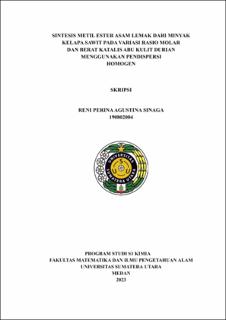Sintesis Metil Ester Asam Lemak dari Minyak Kelapa Sawit pada Variasi Rasio Molar dan Berat Katalis Abu Kulit Durian Menggunakan Pendispersi Homogen

Date
2023Author
Sinaga, Reni Perina Agustina
Advisor(s)
Tarigan, Juliati
Metadata
Show full item recordAbstract
The synthesis of fatty acid methyl esters from palm oil has been performed through a transesterification reaction using durian peel ash as a heterogeneous catalyst. This research was conducted to determine the maximum conversin of fatty acid methyl esters obtained at the ratio oil: methanol (1:6, 1:9, 1:12, 1:15, 1:18, 1:21) and
catalyst weight (5%, 7%, 9%, 12% , 15%) (w/w) at a stirring speed of 5000 rpm for a reaction time of 10 minutes. The conversion of fatty acid methyl esters was analyzed by gas chromatography and the change in functional groups from oil to fatty acid methyl esters was determined by FT-IR spectrophotometry. The highest conversion of fatty acid methyl esters for the molar ratio of palm oil to methanol and catalyst weight was obtained at 95,81 ± 0,7% , namely at a molar ratio of 1:15,stiring speed 5000 rpm, catalyst weight 5% w/w, reaction time 10 minutes. And for the highest yield of fatty acid methyl esters for an oil molar ratio of 97,07 ± 1,5%, namely at a molar ratio of 1 :21, stiring speed 5000rpm, catalyst weight 5% w/w, reaction time 10 minutes, and for catalyst weight of 94,29 ± 1,8%, namely at a molar ratio of 1 : 15, string speed 5000rpm, catalyst weight 7% w/w, raction time 10 minutes. The formation of fatty acid methyl esters was identified using an FT-IR spectrophotometer where there were 3 stretching vibration peaks -C-O-C- at wave numbers 1300-1000 cm-1. The stretching vibration –C-O-C- in palm oil has a strongest peak in the middle (second) position, while for fatty acid methyl esters it is strongest in the rightmost position.
Collections
- Undergraduate Theses [1393]
